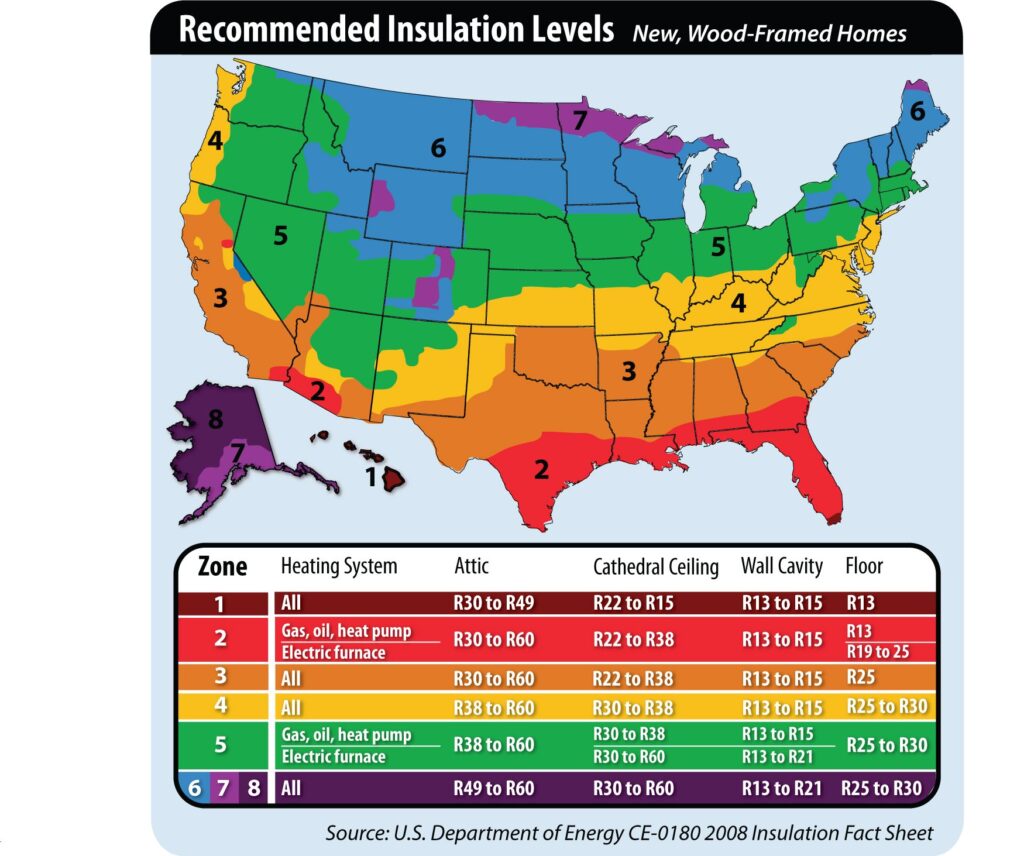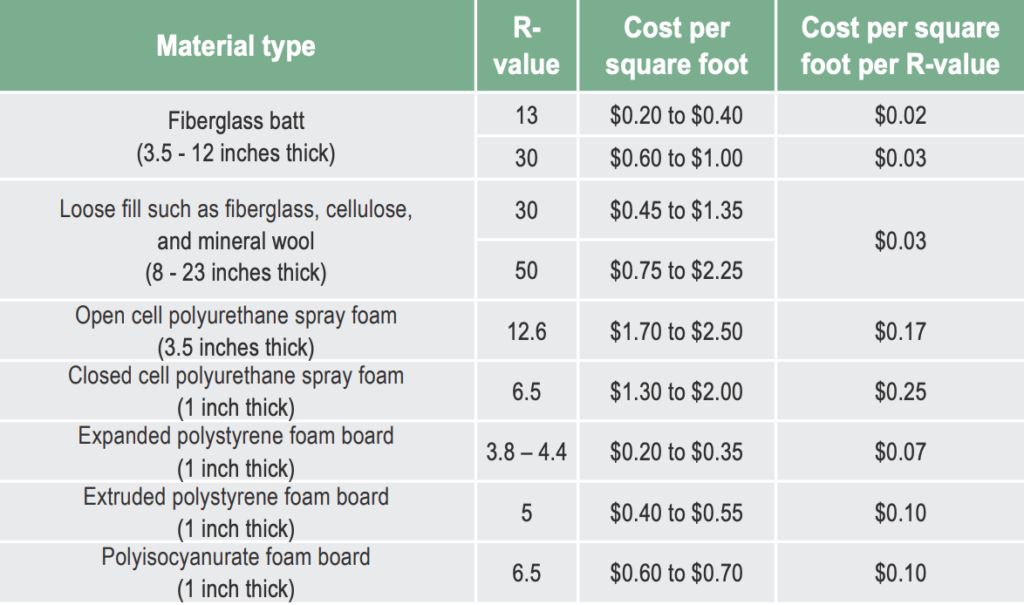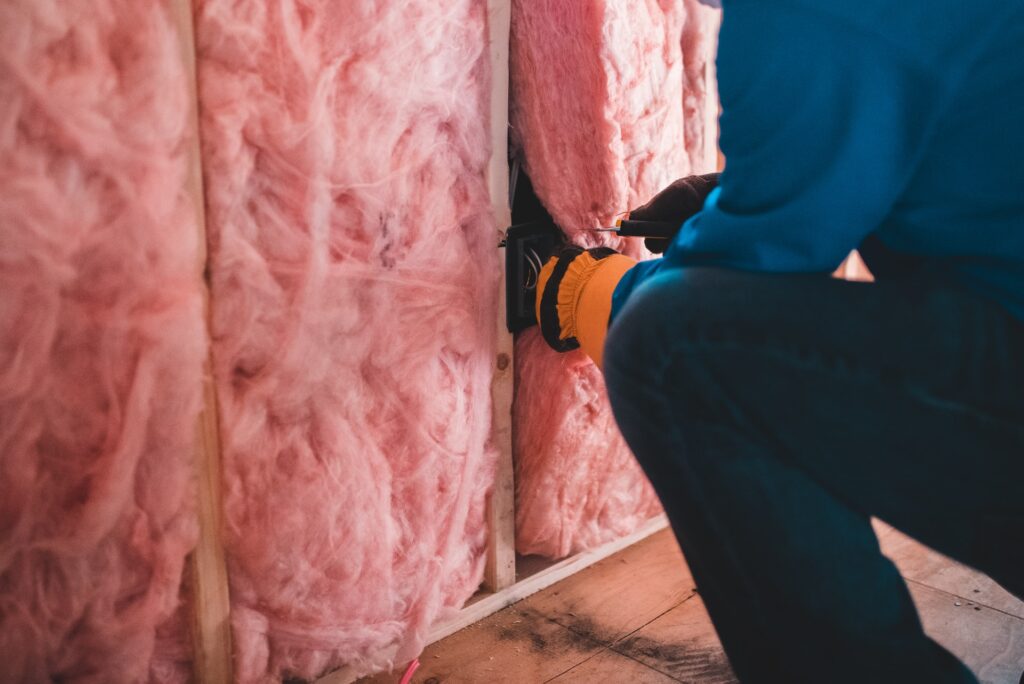Homeowners in America spend a lot of money heating and cooling their homes. Unfortunately much of that energy is wasted due to poor insulation.
In addition to wasting money, poorly insulated homes are just less comfortable. They’re drafty and difficult to keep at the right temperature, which results in a home that’s too cold in the winter and too hot in the summer.
Improving your home’s insulation is a great way to save money, improve your comfort, and cut your carbon footprint. Depending on where you live you could save between $200-500 on your utility bill and cut your carbon footprint by 500-1,000 kilograms (0.5-1 metric ton) per year.
In this guide, we’ll help you understand how much you can save based on where you live and how to get started without breaking the bank. If you’re ready to work on an insulation project, check out our insulation buyer’s guide.
How much does insulation cost?
The cost and savings from insulating your home depend on a few different factors: your climate, the age of your home, and existing insulation.
Climate
What insulation you need—and therefore what it’s going to cost—is almost entirely based on your local climate. Hotter climates will be able to get by with minimal insulation by stopping air leakage, while houses in colder climates will require more insulation (in addition to modifying the home to stop air leakage).
This map by the Energy Department is a good place to start to understand how much insulation you need. If R-values don’t mean anything to you, check out our insulation buyer’s guide.

Age of the house
As with most things home ownership, the older your home, the harder—and more expensive—it will be to install insulation. There are a few reasons:
- Older homes were often built without any insulation, so in order to install what is currently recommended for your climate, you may need to substantially retrofit your home to make room for it. If that’s the case, you’ll need to consider the costs of that project on top of the cost of insulating.
- If you have an older house, you’ll also want to have an electrician involved: adding insulation to a home with aging electric wiring may be a fire hazard. (Never a dull moment with old homes.)
- Houses built before 1978 might have asbestos in them, and if you’re digging into the walls for insulation, that will require specialized removal and will increase the cost.
Size of the house
The bigger the house, the more it’ll cost to insulate. Simple as that. You’ll need more insulation, and it’ll take longer to install, so it’ll be more expensive.
The main reason for this is that insulation is priced per square foot and takes quite a bit of manual labor to install.
Existing insulation
What insulation you currently have will impact the cost of upgrading. Modern insulation (in the form of fiberglass) was only invented in 1932—homes older than that used anything from horse hair to newspaper for insulation. Hopefully some previous owners took care of that and you don’t have horse hair in your walls, but stranger things have happened in old homes.
Upfront insulation costs
Improving your insulation isn’t as expensive as switching to a heat pump HVAC system, but it’s more definitely a bigger investment than small energy efficiency improvements like installing LED lighting.
Your upfront costs will depend on all the factors listed above: an old home in a cold climate with minimal existing insulation will cost the most; a newer home in a warm climate with decent existing installation will cost the least.
But it’s helpful to at least have a baseline estimate. So we analyzed data from the Energy Department to estimate how much the average insulation project costs in each state.
So what are you paying for when you invest in upgrading your home’s insulation? Generally the costs can be broken down into three categories:
- The insulation itself
- The labor cost to install it (if you’re hiring someone to do it)
- Any additional parts needed to install or optimize the insulation
Unit costs of insulation
Insulation is usually quoted per square foot. Depending on what insulation you want, the cost per square foot can range anywhere from $0.20 to $2.00, so if you have a big house, the type of insulation will drastically change your cost.
Take a look at the table below from the Energy Department for estimated costs of various types of insulation. If you don’t know what type of insulation you need, read our insulation buyer’s guide.

Labor
You’ll be paying whoever installs your insulation. It’s a highly specialized skill and not without risks, so this can be expensive. You’ll want to call around for several quotes before picking a contractor.
Additional parts
If you’re installing it yourself, you won’t have to pay for labor, but it’ll come with other costs. You’ll need personal protective equipment (PPE) such as gloves, masks, and sometimes even respirators. Why? Because many types of insulation, like fiberglass, are irritants to human skin, and others, polyurethane foam, can cause dangerous vapors to form when they’re installed.
You might also need to pay for things like radiant barriers, moisture barriers, pipe blankets, ducting insulation, and foil tape. These help either protect the insulation or help the insulation work better by limiting heat loss/gain.
Savings from insulating your home
So how much can you expect to save after you improve your home’s insulation? Once again, that will depend on where you live, the size and age of your home, and the existing insulation.
But averages can be a good place to start. So we crunched some data from the Energy Department to create this table that shows the average annual savings you can expect in each state, based on the type of insulation project.
In addition to saving money every month on your utility bill, you’ll also save money whenever you replace your home heating and cooling system (ideally with an energy efficient option like a heat pump). That’s because the better your insulation, the smaller your heating and cooling system needs to be. And the smaller the system, the lower the upfront cost.
Carbon footprint reduction from insulating your home
In addition to saving money, you can also reduce your carbon footprint a lot by insulating your home. That’s because less energy (whether it’s electricity, gas, or fuel oil) means less carbon emissions.
We analyzed data from the Energy Department to estimate how much the average insulation project can reduce a homeowner’s carbon footprint in each state based on the type of project. (The table shows the kilograms of CO2 emissions per household per year).
If you’re looking for other ways to cut your carbon footprint check out these other guides we produced:
- How to save money and energy by switching to a heat pump
- How much can you save by switching to LED lighting?
- How to save energy by replacing your water heater
Energy audit for insulation
Before you go out and buy insulation or hire a contractor, it’s worth getting an official energy audit from someone using the Manual J standard from the Air Conditioning Contracts of America (ACCA, the official trade group for space heating and cooling in the United States).
This energy audit will find your exact heating and cooling needs using the industry standard method and will be able to find the exact type of insulation you currently have and what you need for your specific area—and how much of it.
Sometimes the audits will be provided for free by your local utility or government, or even as a complimentary service from the contractor you plan to work with. Other times, you’ll have to pay for it.
Here’s the program for my local utility as an example. It provides the audit (which includes recommendations for sizing) for free, and it provides rebates if you work with one of their vetted contractors.
Utility and government programs for insulation rebates
Your local utility has as much of an incentive to cut your home energy use as you do. Yes, it means they’re able to sell you less energy, but to the provider, it’s worth more today to avoid the potential costs of producing more energy. Energy efficiency allows the utility to continue to run the power grid with the existing power plants and lines even with population growth, and not have to make costly investments in new power plants or power lines that may not pay for themselves for decades.
In part because of this, all utilities run some sort of residential energy efficiency program to help offset some of the costs of retrofitting or upgrading your insulation. These programs can either be tax credits from your state or local government, rebate programs where you can mail in proof-of-purchase to get money back, or programs where the utility vets local contractors and helps cover the cost of installation.
You can use this link to see what program, if any, your utility is running for insulation. You can also search online to see if a local organization is running weatherization or building envelope programs—those are different terms for installing or upgrading insulation.
Read our other guides
We’re on a mission to help homeowners dramatically reduce the amount of energy they use. If your interested in saving money and doing something good for the planet in the process, check out one of our other guides:
